Modeling the Solubility of Phenolic Acids in Aqueous Media at 37 °C
Abstract
1. Introduction
2. Results
3. Discussion
4. Materials and Methods
4.1. Materials
4.2. Solubility Apparatus and Procedure
4.3. Thermodynamic Modeling
4.4. Statistical Analysis
5. Conclusions
Supplementary Materials
Author Contributions
Funding
Institutional Review Board Statement
Informed Consent Statement
Data Availability Statement
Acknowledgments
Conflicts of Interest
Sample Availability
References
- Malacaria, L.; Corrente, G.A.; Beneduci, A.; Furia, E.; Marino, T.; Mazzone, G. A review on coordination properties of Al(III) and Fe(III) towards natural antioxidant molecules: Experimental and theoretical insights. Molecules 2021, 26, 2603. [Google Scholar] [CrossRef]
- Furia, E.; Beneduci, A.; Russo, N.; Marino, T. Structural characterization of aluminium (III) and iron (III) complexes of coumarinic acid in aqueous solution from combined experimental and theoretical investigations. New J. Chem. 2018, 42, 11006–11012. [Google Scholar] [CrossRef]
- Beneduci, A.; Corrente, G.A.; Marino, T.; Aiello, D.; Bartella, L.; Di Donna, L.; Napoli, A.; Russo, N.; Romeo, I.; Furia, E. Insight on the chelation of aluminum(III) and iron(III) by curcumin in aqueous solution. J. Mol. Liq. 2019, 296, 111805–111814. [Google Scholar] [CrossRef]
- Corrente, G.A.; Malacaria, L.; Beneduci, A.; Furia, E.; Marino, T.; Mazzone, G. Experimental and theoretical study on the coordination properties of quercetin towards aluminum(III), iron(III) and copper(II) in aqueous solution. J. Mol. Liq. 2021, 325, 115171–115182. [Google Scholar] [CrossRef]
- Boskou, D. Sources of natural phenolic antioxidants. Trends Food Sci. Technol. 2006, 17, 505–512. [Google Scholar]
- Queimada, A.J.; Mota, F.L.; Pinho, S.P.; Macedo, E.A. Solubilities of Biologically Active Phenolic Compounds: Measurements and Modeling. J. Phys. Chem. B 2009, 113, 3469–3476. [Google Scholar] [CrossRef]
- Du, L.; Yu, P.; Rossnagel, B.G.; Christensen, D.A.; McKinnon, J.J. Physicochemical Characteristics, Hydroxycinnamic Acids (Ferulic Acid, p-Coumaric Acid) and Their Ratio, and in Situ Biodegradability: Comparison of Genotypic Differences among Six Barley Varieties. J. Agric. Food Chem. 2009, 57, 4777–4783. [Google Scholar] [CrossRef]
- Robbins, R.J. Phenolic Acids in Foods: An Overview of Analytical Methodology. J. Agric. Food Chem. 2003, 51, 2866–2887. [Google Scholar] [CrossRef]
- Cione, E.; La Torre, C.; Cannataro, R.; Caroleo, M.C.; Plastina, P.; Gallelli, L. Quercetin, epigallocatechin gallate, curcumin and resveratrol: From dietary sources to human microRNA modulation. Molecules 2020, 25, 63. [Google Scholar] [CrossRef] [PubMed]
- Galanakis, C.M.; Goulas, V.; Tsakona, S.; Manganaris, G.A.; Gekas, V. A Knowledge Base for The Recovery of Natural Phenols with Different Solvents. Int. J. Food Prop. 2013, 16, 382–396. [Google Scholar] [CrossRef]
- Petrucci, R.; Astolfi, P.; Greci, L.; Firuzi, O.; Saso, L.; Marrosu, G. A spectroelectrochemical and chemical study on oxidation of hydroxycinnamic acids in aprotic medium. Electrochim. Acta 2007, 52, 2461–2470. [Google Scholar] [CrossRef]
- Fernandes, C.I.S.; Rebelo, M.J.F. Polyphenolic Biosensors. Application in Red Wines. Port. Electrochim. Acta 2009, 27, 457–462. [Google Scholar] [CrossRef]
- Arribas, A.S.; Martìnez-Fernàndez, M.; Chicharro, M. The role of electroanalytical techniques in analysis of polyphenols in wine. Trends Anal. Chem. 2012, 34, 78–96. [Google Scholar] [CrossRef]
- Clifford, M.N. Chlorogenic acids and other cinnamates–nature, occurrence and dietary burden. J. Sci. Food Agric. 1999, 79, 362–372. [Google Scholar] [CrossRef]
- Singh, S.K.; Kundu, A.; Kishore, N. Interactions of some amino acids and glycine peptides with aqueous sodium dodecyl sulfate and cetyltrimethylammonium bromide at T = 298.15 K: A volumetric approach. J. Chem. Thermodyn. 2004, 36, 7–16. [Google Scholar] [CrossRef]
- Soto, A.; Arce, A.; Khoshkbarchi, M.K. Thermodynamics of Diglycine and Triglycine in Aqueous NaCl Solutions: Apparent Molar Volume, Isentropic Compressibility, and Refractive Index. J. Sol. Chem. 2004, 33, 11–21. [Google Scholar] [CrossRef]
- Poulson, S.R.; Harrington, R.R.; Drever, J.I. The solubility of toluene in aqueous salt solutions. Talanta 1999, 48, 633–641. [Google Scholar] [CrossRef]
- Goȑgényi, M.; Dewulf, J.; Van Langenhove, H.; Héberger, K. Aqueous salting-out effect of inorganic cations and anions on non-electrolytes. Chemosphere 2006, 65, 802–810. [Google Scholar] [CrossRef]
- Bullister, J.L.; Wisegarver, D.P.; Menzia, F.A. The solubility of sulfur hexafluoride in water and seawater. Deep Sea Res. Part I Oceanogr. Res. Pap. 2002, 49, 175–187. [Google Scholar] [CrossRef]
- Falcone, G.; Giuffrè, O.; Sammartano, S. Acid-base and UV properties of some aminophenol ligands and their complexing ability towards Zn2+ in aqueous solution. J. Mol. Liquids 2011, 159, 146–151. [Google Scholar] [CrossRef]
- Bretti, C.; Giuffrè, O.; Lando, G.; Sammartano, S. Solubility, protonation and activity coefficients of some aminobenzoic acids in NaClaq and (CH3)4NClaq, at different salt concentrations, at T = 298.15K. J. Mol. Liq. 2015, 212, 825–832. [Google Scholar] [CrossRef]
- Long, F.A.; McDevit, W.F. Activity coefficients of nonelectrolyte solutes in aqueous salt solutions. Chem. Rev. 1952, 50, 119–169. [Google Scholar] [CrossRef]
- Debye, P. Das elektrische Ionenfeld und das Aussalzen. Z. Phys. Chem. 1927, 130, 56–65. [Google Scholar] [CrossRef]
- Kruyt, H.R.; Robinson, C. The Stability of Suspensoids under Influence of Electrolyte Mixture on Lyotropie. Proc. Acad. Sci. Amst. 1926, 29, 1244. [Google Scholar]
- Porto, R.; Furia, E. On the complexation of copper (II) ion with 2-hydroxybenzamide. Ann. Chim. 2007, 97, 187–198. [Google Scholar] [CrossRef] [PubMed]
- Furia, E.; Falvo, M.; Porto, R. Solubility and Acidic Constants of l-Cystine in NaClO4 Aqueous Solutions at 25 °C. J. Chem. Eng. Data 2009, 54, 3037–3042. [Google Scholar] [CrossRef]
- Furia, E.; Nardi, M.; Sindona, G. Standard Potential and Acidic Constants of Oleuropein. J. Chem. Eng. Data 2010, 55, 2824–2828. [Google Scholar] [CrossRef]
- Furia, E.; Napoli, A.; Tagarelli, A.; Sindona, G. Speciation of 2-Hydroxybenzoic Acid with Calcium(II), Magnesium(II), and Nickel(II) Cations in Self-Medium. J. Chem. Eng. Data 2013, 58, 1349–1353. [Google Scholar] [CrossRef]
- Furia, E.; Sindona, G.; Tagarelli, A. Solubility and acidic constants at 25 °C in NaClO4 aqueous solutions of 1-(2-hydroxyphenyl)ethenone. Monatsh. Chem. 2016, 147, 1009–1014. [Google Scholar] [CrossRef]
- Noubigh, A.; Cherif, M.; Provost, E.; Abderrabba, M. Solubility of Gallic Acid, Vanillin, Syringic Acid, and Protocatechuic Acid in Aqueous Sulfate Solutions from (293.15 to 318.15) K. J. Chem. Eng. Data 2008, 53, 1675–1678. [Google Scholar] [CrossRef]
- Calado, M.S.; Branco, A.S.H.; Najdanovic-Visak, V.; Visak, Z.P. Solubility of high-value compounds in environmentally friendly solvents-liquid poly(ethylene glycol) and ionic liquids: Experimental study and thermodynamic analysis. J. Chem. Thermodyn. 2014, 70, 154–159. [Google Scholar] [CrossRef]
- Mota, F.L.; Queimada, A.J.; Pinho, S.P.; Macedo, E.A. Aqueous Solubility of Some Natural Phenolic Compounds. Ind. Eng. Chem. Res. 2008, 47, 5182–5189. [Google Scholar] [CrossRef]
- Alevizou, E.I.; Voutsas, E.C. Solubilities of p-coumaric and caffeic acid in ionic liquids and organic solvents. J. Chem. Thermodyn. 2013, 62, 69–78. [Google Scholar] [CrossRef]
- Lu, L.-L.; Lu, X.-Y. Solubilities of Gallic Acid and Its Esters in Water. J. Chem. Eng. Data 2007, 52, 37–39. [Google Scholar] [CrossRef]
- Murga, R.; Sanz, M.T.; Beltrán, S.; Cabezas, J.L. Solubility of three hydroxycinnamic acids in supercritical carbon dioxide. J. Supercrit. Fluids 2003, 27, 239–245. [Google Scholar] [CrossRef]
- Murga, R.; Sanz, M.T.; Beltrán, S.; Cabezas, J.L. Solubility of Syringic and Vanillic Acids in Supercritical Carbon Dioxide. J. Chem. Eng. Data 2004, 49, 779–782. [Google Scholar] [CrossRef]
- Manic, M.S.; Villanueva, D.; Fornari, T.; Queimada, A.J.; Macedo, E.A.; Najdanovic–Visak, V. Solubility of high-value compounds in ethyl lactate: Measurements and modelling. J. Chem. Thermodyn. 2012, 48, 93–100. [Google Scholar] [CrossRef]
- Crea, F.; Crea, P.; De Stefano, C.; Giuffrè, O.; Pettignano, A.; Sammartano, S. Thermodynamic Parameters for the Protonation of Poly(allylamine) in Concentrated LiCl(aq) and NaCl(aq). J. Chem. Eng. Data 2004, 49, 658–663. [Google Scholar] [CrossRef]
- Daneshfar, A.; Ghaziaskar, H.S.; Homayoun, N. Solubility of Gallic Acid in Methanol, Ethanol, Water, and Ethyl Acetate. J. Chem. Eng. Data 2008, 53, 776–778. [Google Scholar] [CrossRef]
- Noubigh, A.; Jeribi, C.; Mgaidi, A.; Abderrabba, M. Solubility of gallic acid in liquid mixtures of (ethanol+water) from (293.15 to 318.15)K. J. Chem. Thermodyn. 2012, 55, 75–78. [Google Scholar] [CrossRef]
- Noubigh, A.; Aydi, A.; Mgaidi, A.; Abderrabba, M. Measurement and correlation of the solubility of gallic acid in methanol plus water systems from (293.15 to 318.15) K. J. Mol. Liquids 2013, 187, 226–229. [Google Scholar] [CrossRef]
- De Stefano, C.; Foti, C.; Giuffrè, O.; Sammartano, S. Acid–base and UV behavior of 3-(3,4-dihydroxyphenyl)-propenoic acid (caffeic acid) and complexing ability towards different divalent metal cations in aqueous solution. J. Mol. Liquids 2014, 195, 9–16. [Google Scholar] [CrossRef]
- Noubigh, A.; Mgaidi, A.; Abderrabba, M.; Provost, E.; Fürst, W. Effect of salts on the solubility of phenolic compounds: Experimental measurements and modelling. J. Sci. Food Agric. 2007, 87, 783–788. [Google Scholar] [CrossRef]
- Delmondes, P.H.; Stefani, R. Computational study of natural phenolic acid solubility and their interactions with chitosan. MOL2NET 2016, 2. [Google Scholar] [CrossRef]
- Abraham, M.H. Scales of solute hydrogen-bonding: Their construction and application to physicochemical and biochemical processes. Chem. Soc. Rev. 1992, 96, 73–83. [Google Scholar] [CrossRef]
- Vilas-Boas, S.M.; Vieira, V.; Brandão, P.; Alves, R.S.; Coutinho, J.A.P.; Pinho, S.P.; Ferreira, O. Solvent and temperature effects on the solubility of syringic, vanillic or veratric acids: Experimental, modeling and solid phase studies. J. Mol. Liq. 2019, 289, 111089–111098. [Google Scholar] [CrossRef]
- Vilas-Boas, S.M.; Vieira, V.; Brandão, P.; Alves, R.S.; Coutinho, J.A.P.; Pinho, S.P.; Ferreira, O. Solid-liquid phase equilibrium of trans-cinnamic acid, p-coumaric acid and ferulic acid in water and organic solvents: Experimental and modelling studies. Fluid Phase Equilibria 2020, 521, 112747–112756. [Google Scholar] [CrossRef]
- Bretti, C.; Cigala, R.M.; Crea, F.; Foti, C.; Sammartano, S. Solubility and activity coefficients of acidic and basic non-electrolytes in aqueous salt solutions: 3. Solubility and activity coefficients of adipic and pimelic acids in NaCl(aq), (CH3)4NCl(aq) and (C2H5)4NI(aq) at different ionic strengths and at t = 25 °C. Fluid Phase Equilibria 2008, 263, 43–54. [Google Scholar]
- Furia, E.; Sindona, G. Interaction of Iron(III) with 2-Hydroxybenzoic Acid in Aqueous Solutions. J. Chem. Eng. Data 2012, 57, 195–199. [Google Scholar] [CrossRef]
- Beneduci, A.; Furia, E.; Russo, N.; Marino, T. Complexation behaviour of caffeic, ferulic and p-coumaric acids towards aluminium cations: A combined experimental and theoretical approach. New J. Chem. 2017, 41, 5182–5190. [Google Scholar] [CrossRef]
- Porwal, S.K.; Furia, E.; Harris, M.E.; Viswanathan, R.; Devireddy, L. Synthetic, potentiometric and spectroscopic studies of chelation between Fe(III) and 2,5-DHBA supports salicylate-mode of siderophore binding interactions. J. Inorg. Biochem. 2015, 145, 1–10. [Google Scholar] [CrossRef]
- Bitencourt, R.G.; Cabral, F.A.; Meirelles, A.J.A. Ferulic acid solubility in supercritical carbon dioxide, ethanol and water mixtures. J. Chem. Thermodyn. 2016, 103, 285–291. [Google Scholar] [CrossRef]
- Shakeel, F.; Salem-Bekhit, M.M.; Haqa, N.; Siddiqui, N.A. Solubility and thermodynamics of ferulic acid in different neat solvents: Measurement, correlation and molecular interactions. J. Mol. Liq. 2017, 236, 144–150. [Google Scholar] [CrossRef]
- Noubigh, A.; Cherif, M.; Provost, E.; Abderrabba, M. Solubility of some phenolic compounds in aqueous alkali metal nitrate solutions from (293.15 to 318.15) K. J. Chem. Thermodyn. 2008, 40, 1612–1616. [Google Scholar] [CrossRef]
- Noubigh, A.; Abderrabba, M.; Provost, E. Temperature and salt addition effects on the solubility behaviour of some phenolic compounds in water. J. Chem. Thermodyn. 2007, 39, 297–303. [Google Scholar] [CrossRef]
- Furia, E.; Porto, R. 2-Hydroxybenzamide as a Ligand. Complex Formation with Dioxouranium(VI), Aluminum(III), Neodymium(III), and Nickel(II) Ions. J. Chem. Eng. Data 2008, 53, 2739–2745. [Google Scholar] [CrossRef]
- Cardiano, P.; Giuffrè, O.; Napoli, A.; Sammartano, S. Potentiometric, 1H NMR and ESI-MS investigation on dimethyltin(IV) cation–mercaptocarboxylate interaction in aqueous solution. New J. Chem. 2009, 33, 2286–2295. [Google Scholar] [CrossRef]
- Ciavatta, L. The specific interaction theory in evaluating ionic equilibria. Ann. Chim. 1980, 70, 551–567. [Google Scholar]
- Ciavatta, L. The specific interaction theory in equilibrium analysis. Some empirical rules for estimating interaction coefficients of metal ion complexes. Ann. Chim. 1990, 80, 255–263. [Google Scholar]
- Öhman, L.-O.; Sjöberg, S. Equilibrium and structural studies of silicon(IV) and aluminium(III) in aqueous solution. 1. The formation of ternary mononuclear and polynuclear complexes in the system Al3+-gallic acid-OH-. A potentiometric study in 0.6 M Na(Cl). Acta Chem. Scand. 1981, 35, 201–212. [Google Scholar] [CrossRef][Green Version]
- Sedeh, I.F.; Öhman, L.-O.; Sjöberg, S. Equilibrium and structural studies of silicon(IV) and aluminium(III) in aqueous solution. 30. Aqueous complexation between silicic acid and some ortho-Di- and triphenolic compounds. Acta Chem. Scand. 1992, 46, 933–940. [Google Scholar] [CrossRef]
- Sandmann, B.J.; Chien, M.H.; Sandmann, R.A. Stability constants of calcium, magnesium and zinc gallate using a divalent ion-selective electrode. Anal. Lett. 1985, 18, 149–159. [Google Scholar] [CrossRef]
- Kipton, H.; Powell, J.; Taylor, M.C. Interactions of Iron(II) and Iron(III) with Gallic Acid and its Homologues: A Potentiometric and Spectrophotometric Study. Aust. J. Chem. 1982, 35, 739–756. [Google Scholar]
- Ambulkar, R.S.; Marathe, D.G.; Munshi, K.N. Complexes of gallium(III) with pyrocatechol, pyrogallol & protocatechuic, α-resorcylic, gallic & 2,3-dihydroxynaphthalene-6-sulphonic acids in aqueous medium. Ind. J. Chem. 1981, 20, 1044–1046. [Google Scholar]
- Ozkorucuklu, S.P.; Beltrán, J.L.; Fonrodona, G.; Barrón, D.; Alsancak, G.; Barbosa, J. Determination of Dissociation Constants of Some Hydroxylated Benzoic and Cinnamic Acids in Water from Mobility and Spectroscopic Data Obtained by CE-DAD. J. Chem. Eng. Data 2009, 54, 807–811. [Google Scholar] [CrossRef]
- Beltrán, J.L.; Sanli, N.; Fonrodona, G.; Barrón, D.; Özkan, G.; Barbosa, J. Spectrophotometric, potentiometric and chromatographic pKa values of polyphenolic acids in water and acetonitrile–water media. Anal. Chim. Acta 2003, 484, 253–264. [Google Scholar] [CrossRef]
- Furia, E.; Porto, R. The effect of ionic strength on the complexation of copper (II) with salicylate ion. Ann. Chim. 2002, 92, 521–530. [Google Scholar] [PubMed]
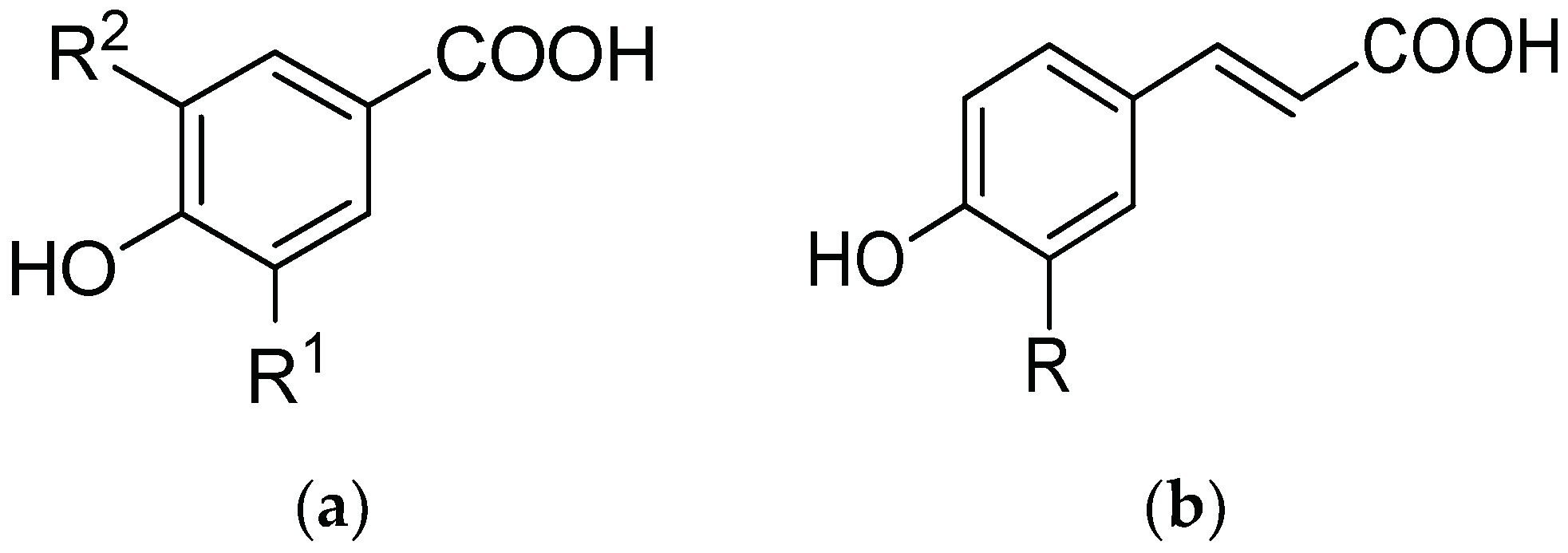
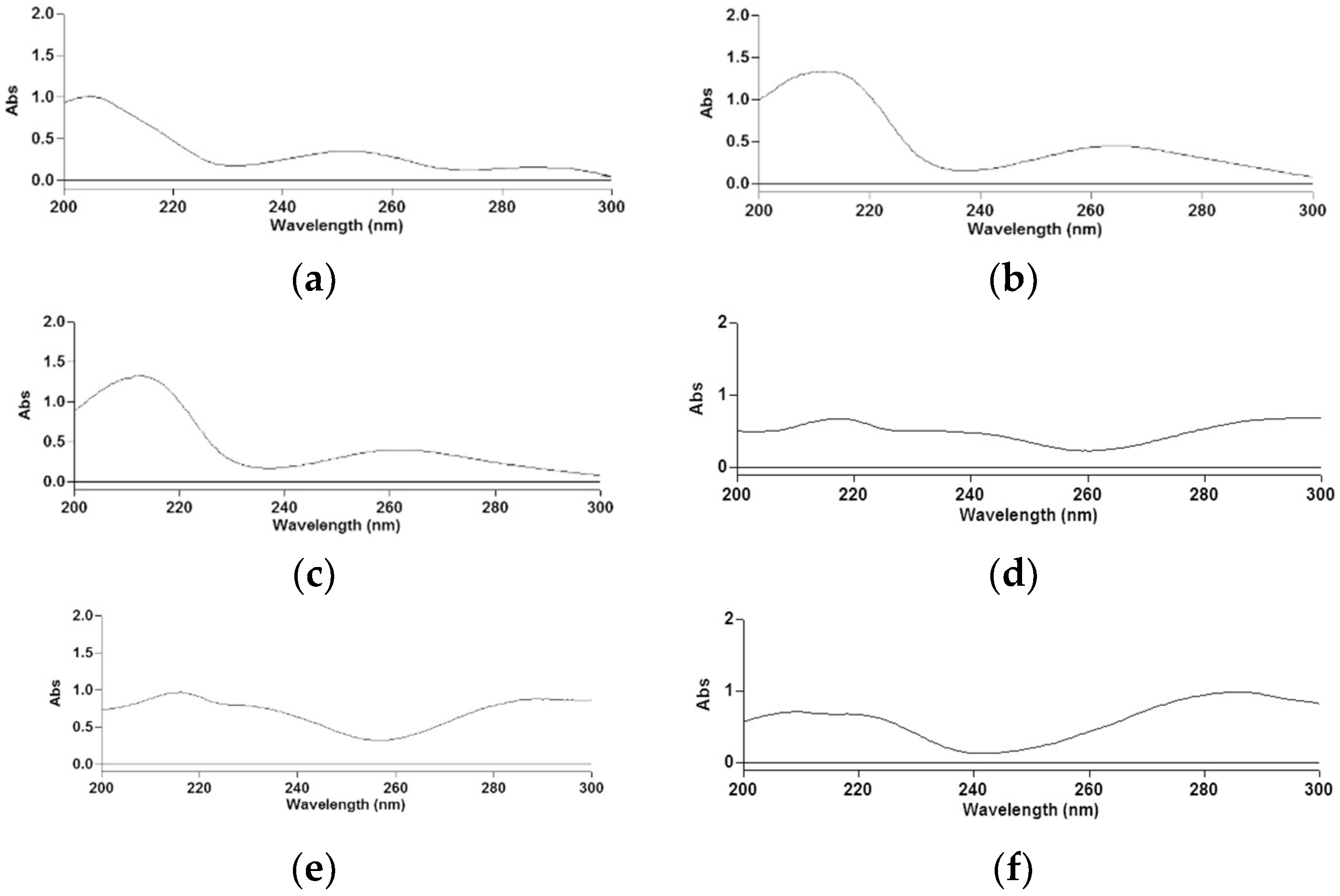
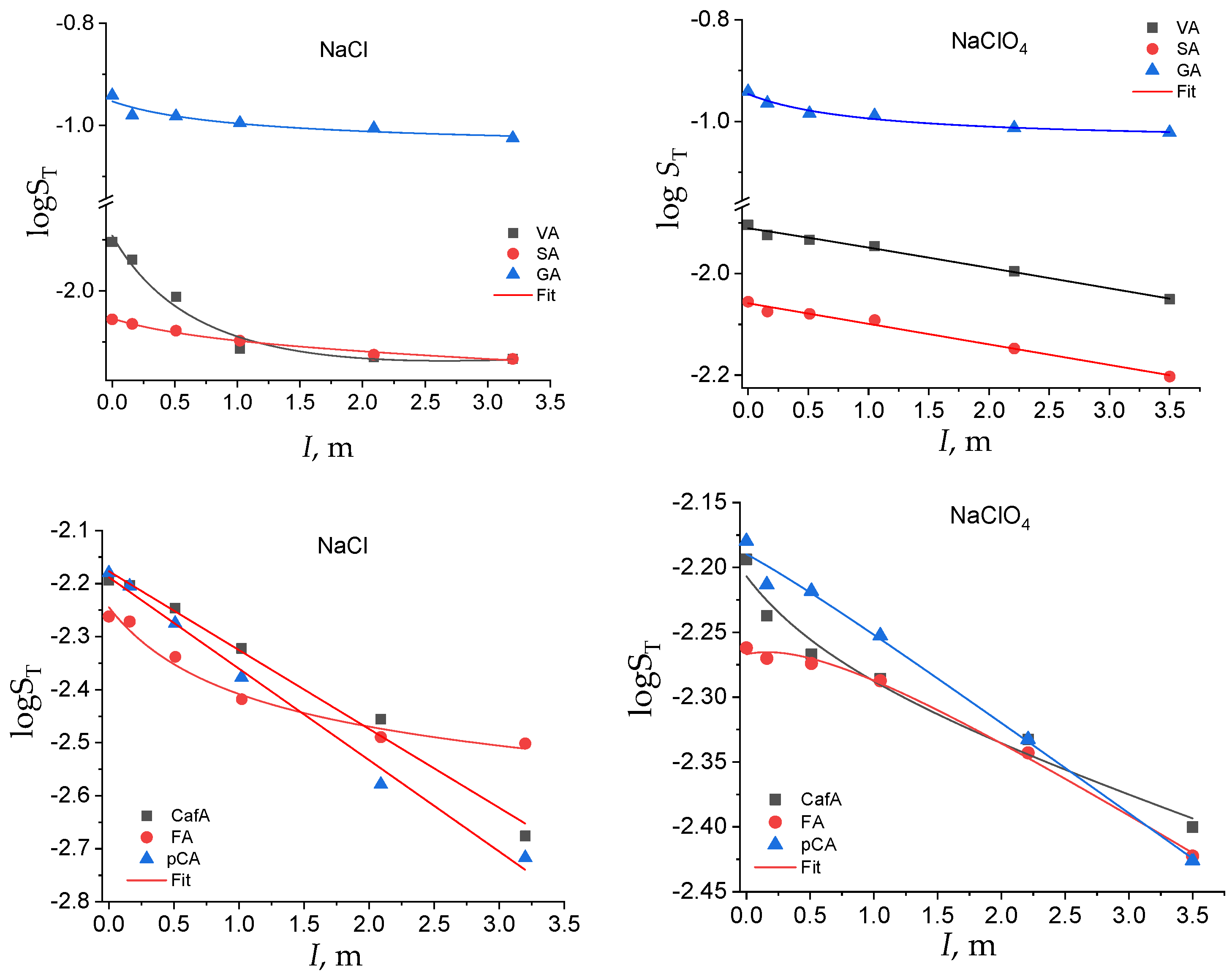
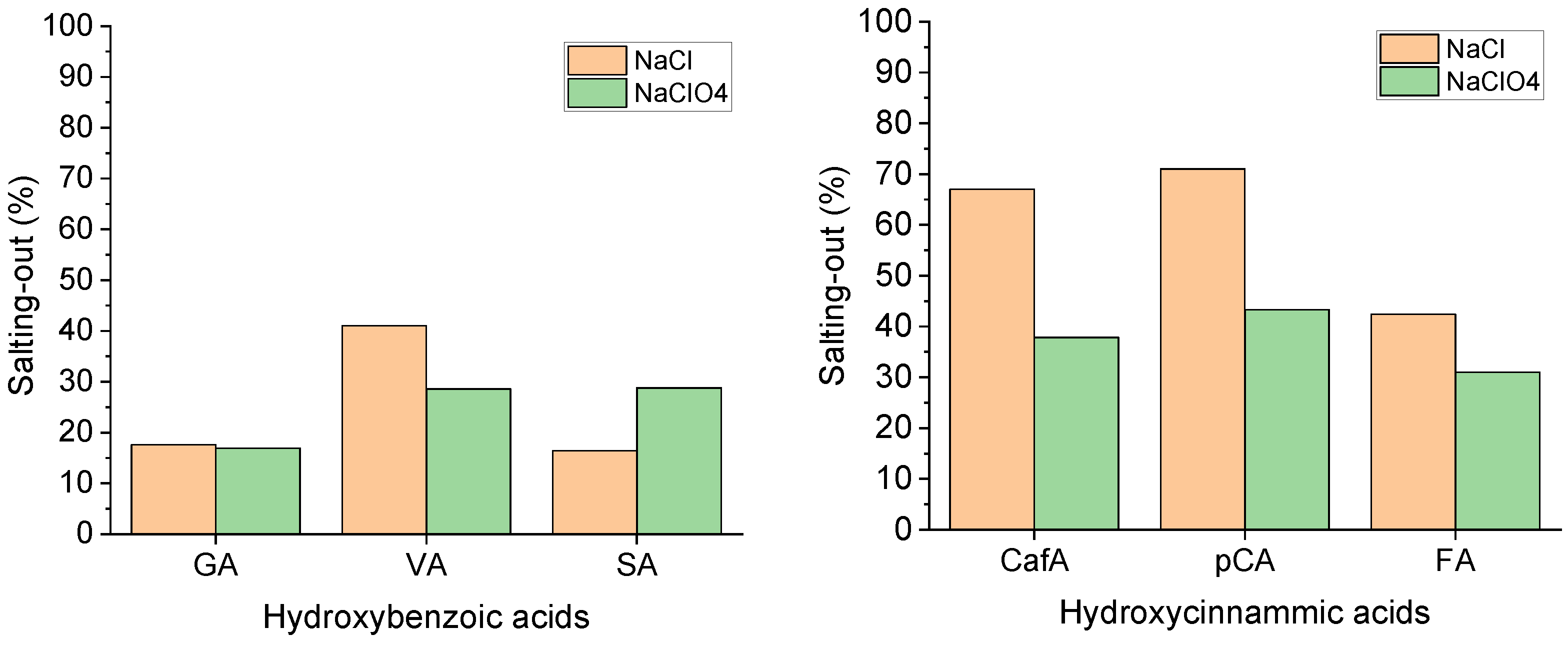
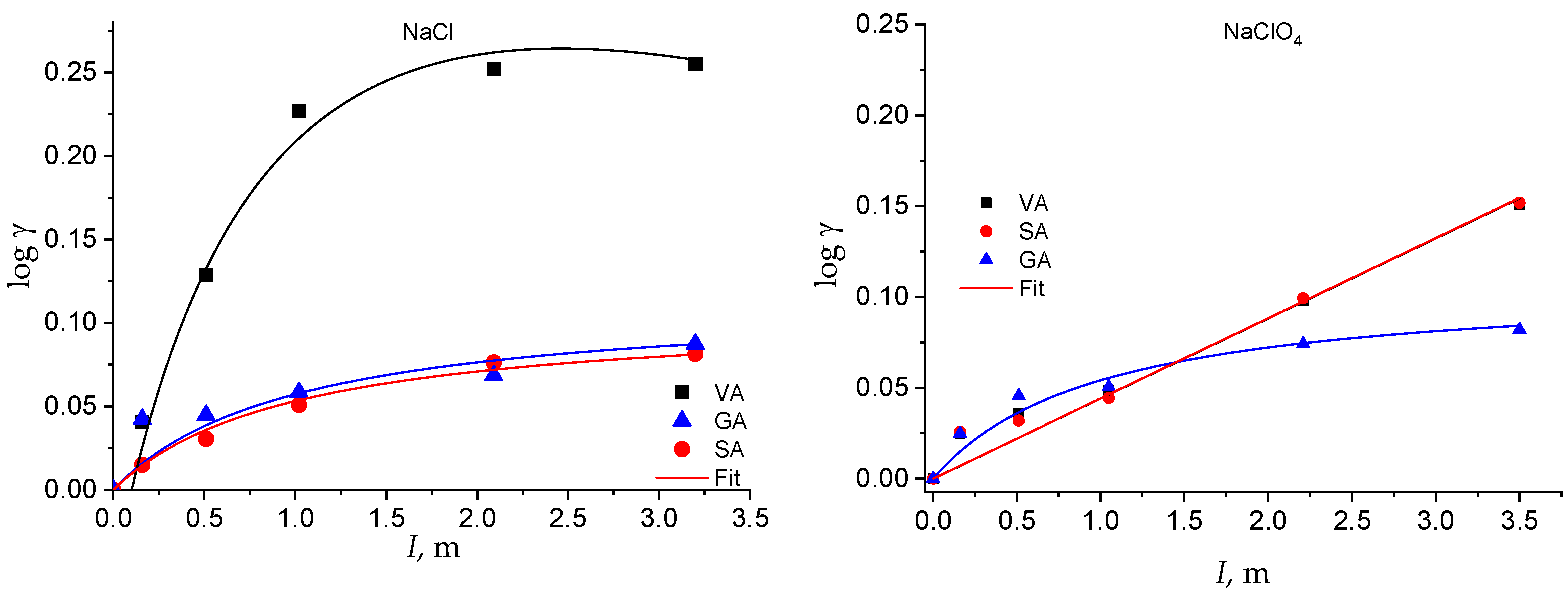
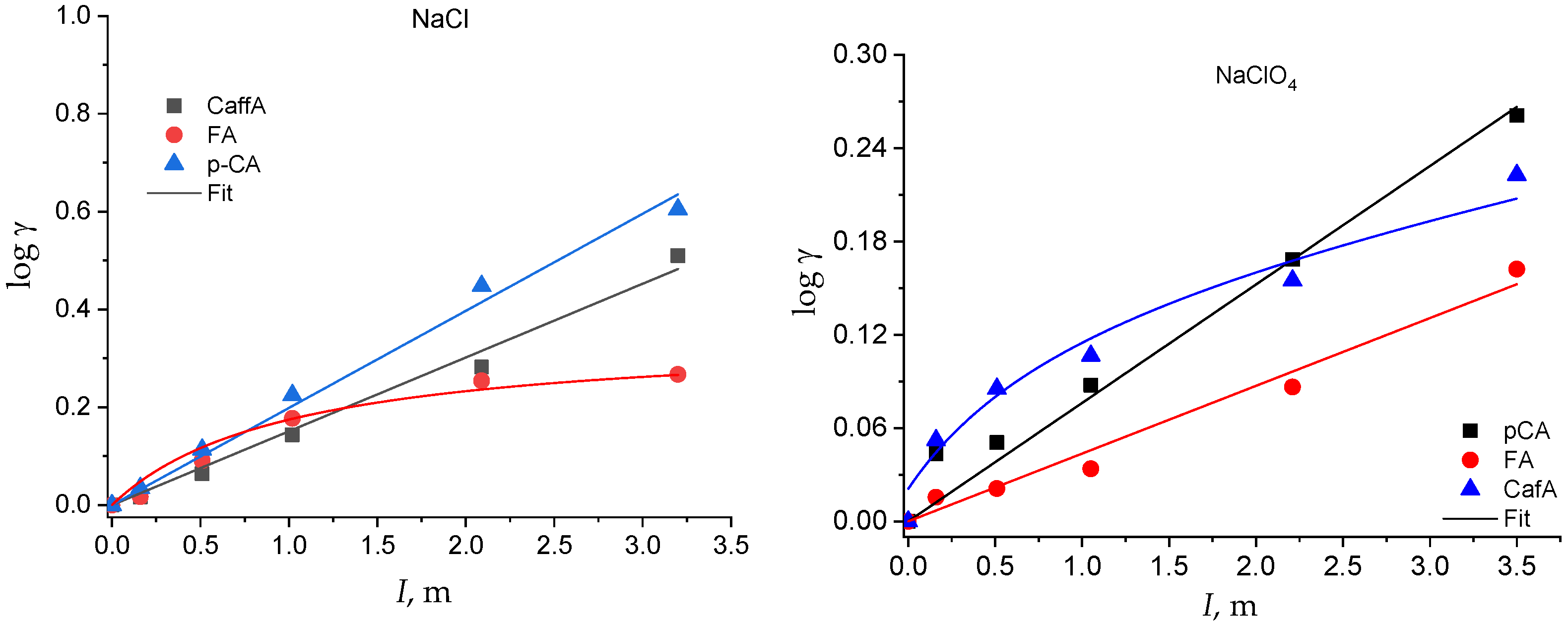
| VA | SA | GA | CafA | FA | p-CA | |
|---|---|---|---|---|---|---|
| H2O | z12.47 ± 0.01 a | y8.8 ± 0.3 a | x114.5 ± 0.3 a | w6.4 ± 0.2 a | v5.47 ± 0.01 a | w6.61 ± 0.01 a |
| I , molal NaCl | ||||||
| 0.16 | z11.52 ± 0.06 b | y8.62 ± 0.03 ab | x104.6 ± 0.3 b | w6.26 ± 0.03 ab | v5.35 ± 0.01 a | w6.24 ± 0.01 a |
| 0.51 | z9.74 ± 0.03 c | y8.36 ± 0.06 ab | x104.2 ± 0.4 bc | w5.67 ± 0.04 bc | v4.59 ± 0.09 b | w5.31 ± 0.01 b |
| 1.02 | z7.7 ± 0.6 d | z7.99 ± 0.05 bc | y101.1 ± 0.1 d | x4.76 ± 0.01 d | w3.82 ± 0.03 c | xw4.19 ± 0.01 cg |
| 2.09 | z7.42 ± 0.05 d | z7.5 ± 0.1 cde | y98.7 ± 0.2 e | x3.50 ± 0.01 e | xw3.24 ± 0.01 cd | w2.64 ± 0.02 d |
| 3.20 | z7.36 ± 0.03 d | z7.36 ± 0.03 ce | y94.4 ± 0.5 f | x2.11 ± 0.03 f | w3.15 ± 0.01 d | x1.92 ± 0.08 e |
| I, molal NaClO4 | ||||||
| 0.16 | z11.92 ± 0.04 ab | y8.42 ± 0.03 ab | x104.6 ± 0.3 b | w5.79 ± 0.04 bc | w5.37 ± 0.01 a | w6.12 ± 0.01 af |
| 0.51 | z11.66 ± 0.04 b | y8.33 ± 0.04 ab | x103.7 ± 0.3 c | w5.41 ± 0.01 c | w5.32 ± 0.01 a | w6.05 ± 0.05 af |
| 1.05 | z11.33 ± 0.03 b | y8.10 ± 0.09 bd | x102.6 ± 0.8 g | w5.18 ± 0.06 cd | w5.16 ± 0.01 ab | w5.59 ± 0.04 bf |
| 2.21 | z10.1 ± 0.1 c | y7.12 ± 0.02 e | x97.1 ± 0.1 h | w4.65 ± 0.04 d | w4.54 ± 0.07 b | w4.65 ± 0.04 c |
| 3.50 | z8.9 ± 0.3 e | y6.27 ± 0.01 f | x95.1 ± 0.1 i | w3.98 ± 0.02 e | w3.78 ± 0.03 cd | w3.75 ± 0.07 g |
| χ‧103 | ||||||||||||||
|---|---|---|---|---|---|---|---|---|---|---|---|---|---|---|
| Phenolic Acids | This Work | Ref. [6] | Ref. [30] | Ref. [32] | Ref. [34] | Ref. [39] | Ref. [41] | Ref. [43] | Ref. [46] | Ref. [52] | Ref. [53] | Ref. [54] | Ref. [55] | |
| H2O | ||||||||||||||
| VA | 0.23 | 0.22 b | 0.24 c 0.26 d | 0.24 | ||||||||||
| GA | 2.10 | 1.33 | 2.79 | 2.16 | 2.50 | 2.66 | 1.31 c 1.38 d | 1.40 | ||||||
| SA | 0.16 | 0.36 | 0.84 | 0.22 b | 0.79 c 0.92 d | 0.85 | ||||||||
| CafA | 0.12 | 0.19 | ||||||||||||
| FA | 0.10 | 0.14 | 0.11 b | 0.113 c; 0.079 d | 0.0807 c; 0.109 d | 0.90 | ||||||||
| p-CA | 0.12 | 0.086 | 0.12 b | |||||||||||
| χ‧103 | ||||||||||||||
| Phenolic Acids | This Work | |||||||||||||
| 1 m NaCl | 1 m KNO3 | 1 m NaNO3 | ||||||||||||
| VA | 0.14 | 0.19 c 0.23 d | 0.17 c 0.20 d | |||||||||||
| GA | 1.85 | 0.98 a | 1.27 c 1.34 d | 1.15 c 1.21 d | ||||||||||
| SA | 0.14 | 0.76 c 0.88 d | 0.71 c 0.88 d | |||||||||||
| FA | 0.07 | |||||||||||||
Publisher’s Note: MDPI stays neutral with regard to jurisdictional claims in published maps and institutional affiliations. |
© 2021 by the authors. Licensee MDPI, Basel, Switzerland. This article is an open access article distributed under the terms and conditions of the Creative Commons Attribution (CC BY) license (https://creativecommons.org/licenses/by/4.0/).
Share and Cite
Furia, E.; Beneduci, A.; Malacaria, L.; Fazio, A.; La Torre, C.; Plastina, P. Modeling the Solubility of Phenolic Acids in Aqueous Media at 37 °C. Molecules 2021, 26, 6500. https://doi.org/10.3390/molecules26216500
Furia E, Beneduci A, Malacaria L, Fazio A, La Torre C, Plastina P. Modeling the Solubility of Phenolic Acids in Aqueous Media at 37 °C. Molecules. 2021; 26(21):6500. https://doi.org/10.3390/molecules26216500
Chicago/Turabian StyleFuria, Emilia, Amerigo Beneduci, Luana Malacaria, Alessia Fazio, Chiara La Torre, and Pierluigi Plastina. 2021. "Modeling the Solubility of Phenolic Acids in Aqueous Media at 37 °C" Molecules 26, no. 21: 6500. https://doi.org/10.3390/molecules26216500
APA StyleFuria, E., Beneduci, A., Malacaria, L., Fazio, A., La Torre, C., & Plastina, P. (2021). Modeling the Solubility of Phenolic Acids in Aqueous Media at 37 °C. Molecules, 26(21), 6500. https://doi.org/10.3390/molecules26216500









